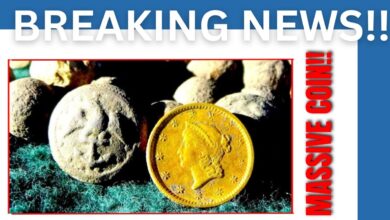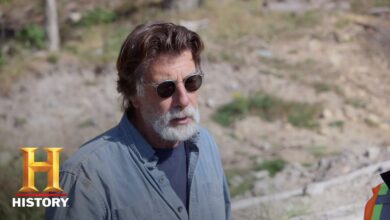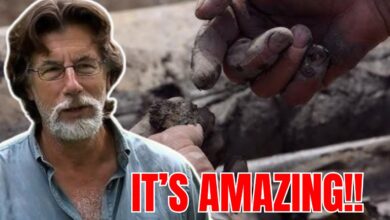The Curse of Oak Island: 500-YEAR-OLD Bronze Coin Discovered On Lot 5 (Season 10)
The Curse of Oak Island: 500-YEAR-OLD Bronze Coin Discovered On Lot 5 (Season 10)

Big day, Rick. I’ve been waiting for this day for a very long time.
I can’t but agree, Gary. Rick Lagina, metal detection expert Gary Drayton, and archaeologist Laird Niven anxiously arrive on Lot 5, located on the western side of Oak Island.
Claire, this must be exciting for you.
Yes, it just bothered me to not have access to it, to have that part of the story missing, and we’ll just add to Robert’s legacy.
That’s the whole point of this—continuing the work that he did for many, many years. A lot is a mystery. Let’s see what we can find.
Okay. When we take down the sign, we realize that it is indeed our responsibility at this point to carry on Robert’s work. This is in the past now, my turn to the future. Let’s get started.
Am I ecstatic? Over the moon to be able to go dig on a lot that has eluded us, the opportunity for answers? 100 percent. You could equate it to being given the keys to the family car when you’re 15 or 16. I didn’t think this day would ever happen. It’s very, very cool.
All right, see what we’ve got waiting for us here.
See what this one sounds like.
I like this.
Let’s see how wide it is, but that’s the center of it.
But it’s rocky, man.
Let’s see if that did anything.
See if I can pinpoint it.
[Music]
Oh.
Survey marker. Yep, that’s the survey marker, mate.
Survey says: don’t dig on top of it.
Okay, so the next targets are down here, mate, and we go in fervent on Lot 5.
Okay.
Robert Young did exhaustive work on his property, and he worked intimately with Fred Nolan.
But he did not have this sophisticated equipment that Gary has.
So, could something of immense value still be hiding on Lot 5? Absolutely.
This is Batman. We’re getting more into Lot 5 now.
We stand the chance of finding something good.
Okay, I’m gonna hold you to it.
Okay.
Oh, that sounds better. It does, doesn’t it?
Yep.
Just that.
Well, there’s nothing rock, and it’s just too rough land to be farmland, isn’t it?
Yeah.
Oh, mate, see if you moved it.
Yep.
Yep, I think you moved it.
Oh.
Look at that. Look at the patina on that.
Oh my God, my hands are shaking, mate. Turn it over.
That’s a cook coin by the look of it.
Yeah.
That’s what they did back in the day. They cut them in apple, cut little bits off for change because that’s why they didn’t cut coins, especially armored coins enough.
And this is freaking gorgeous, mate. And that ain’t no mill coin, mate.
No, to me, mate, this looks like an amid coin. Obviously, it’s not a mill coin. It’s too thin, and if it is amid, mate, it goes way back.
That is all dating back to the first millennium BC.
Hammered coinage was the first known method for creating metal currency in human history. By placing a small blank piece of metal between two patterned surfaces known as dies, repeated hammering would create the stamp or assign value on either side of the coin.
It’s bloody fantastic, mate. But what makes this find potentially important for the team is that the process was replaced by the invention of machines in Europe during the 15th century.
This means that it could be more than 500 years old.
This is a type of find that you would pull up in Europe somewhere, and that’s what makes this so special. That’s treasure, mate.
Yeah. Goodbye. This is special. We have got to bag this. This could be very, very important.
Well, that’s a little mini piece of that there.
Okay.
Get that seal.
You know where that’s going, mate. That’s a bonafide top pocket find, mate.
Deborah saw one. How about getting it right back to the lab and finding out what it is?
I’m good with that. See what the techie machines tell us.
Following their discovery on Lot 5, just the people we want to see: Rick and Gary arrive at the Interpretive Center to have it analyzed by archaeologist Laird Niven and archaeometallurgist Emma Culligan.
But sometimes when we’re in here, and we’re just standing, and Gary and Jack or Gary and Peter come in, right?
And what do we always say?
“Oh, they’re smiling.”
That’s a good sign. That’s a very good sign, especially about this item, Gary.
Well, we just came from Lot 5, right?
Yeah.
And pulled up a nice top pocket find, mate. Don’t worry. It’s still in the bag. Check that out, mate. See what you think of that.
I’ve come to glasses.
Oh, it’s thin. Yeah, it looked like a button at first, but it’s not.
No.
Oh, don’t keep me in suspenders, mate. What do you think?
It’s a cut coin. That’s what I thought as well. The patina is great.
Yeah, we couldn’t tell whether it looked like copper or silver.
Yeah.
I mean, I’ve seen a lot of coins. I’ve actually found amid coins in England, and obviously, I’ve found a lot of Spanish royales in North America, but I haven’t seen this design before.
I just don’t know what I’m looking at.
Well, we can XRF it. That will tell us for sure what this metal is.
Yeah, that’s what we’re hoping you can do, mate.
All right, Emma.
[Music]
I’m hoping it’s silver.
To gain more information on the possible origin of the coin, Emma will use the X-ray fluorescent spectrometer, or XRF device, which can identify the types of elements and metals that make up its composition.
Right now, I’m just going through each peak and identifying all those elements.
It’s preserved like it’s silver, and it looks like it’s copper.
Well, we will soon find out.
All right, it looks mainly copper, some tin, some iron.
That little tiny bump right there is arsenic. So, is it arsenical bronze?
Yeah, it’d be like an arsenical bronze.
Wow, so it’s old.
Yeah, kind of like 1500s and kind of trickled out.
Yeah, by the 1700s, you wouldn’t have seen it whatsoever.
So, it is old.
Yeah, we don’t see arsenical bronze past a certain date, and coins of that size are usually like 16th century, pre-those dates.
Yeah, yeah.
You remember the other arsenical copper, the arsenical bronze that was found on Lot 7?
And this is a couple of lots over, Lot 5, not too far away from each other.
Two months ago, Gary and Jack Begley discovered a barter token on nearby Lot 7, which also contained arsenical bronze and was determined by coin expert Sandy Campbell to potentially predate the 16th century.
It’s 500 years old at least.
Is it possible that the team has just unearthed another critical puzzle piece that could help them determine the origin of the Oak Island mystery?
You can eliminate, for the most part, English and Spanish.
Yeah, right, and I think it’s neither English nor Spanish, so that takes it into some pretty interesting territory.
We have fingerprints now that certainly suggest the 1500s, so it’s starting to craft or weave some sort of texture towards a story component.
Right?
Yeah, I like it when we can add artifacts to the thing and really strengthen our argument that there was early activity here.
Arsenical bronze dating from as early as 1500, and that’s an aha moment. That’s quite remarkable.
What does it mean? You know, it’s like…
I’m up here with “wow, fantastic, 1500s, unbelievable,” right?
Little piece of something telling us that, and then I’m down here like, “but what does it mean?”
It’s all good news.
Lot 5 and Lot 7 are now turning up some really esoteric metals, and we need to find out why.
So, there’s a lot of work to do, but you and I won’t do it in here, right?
So I think we should go back out, find more.
Okay, mate.
All right.
Thanks.
Cheers.
[Foreign]








